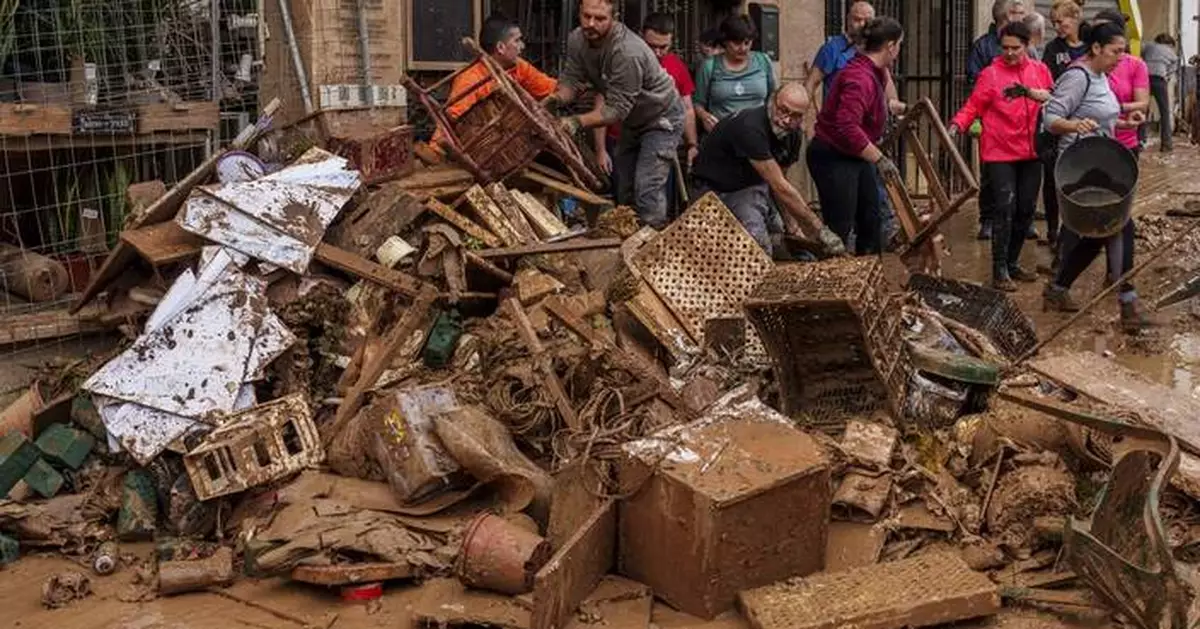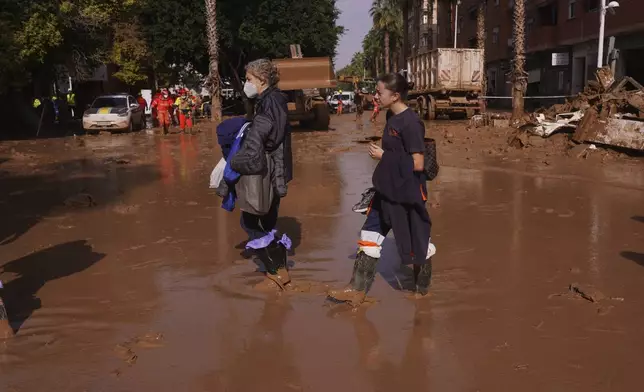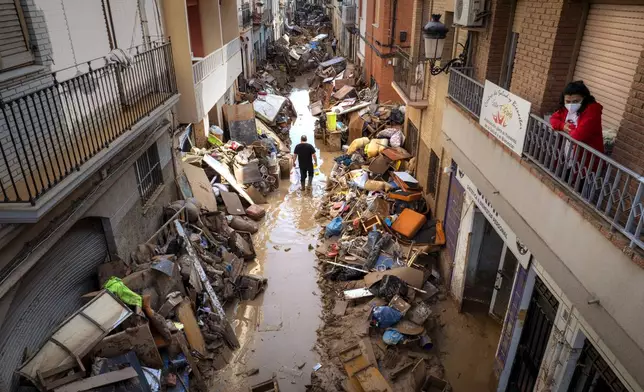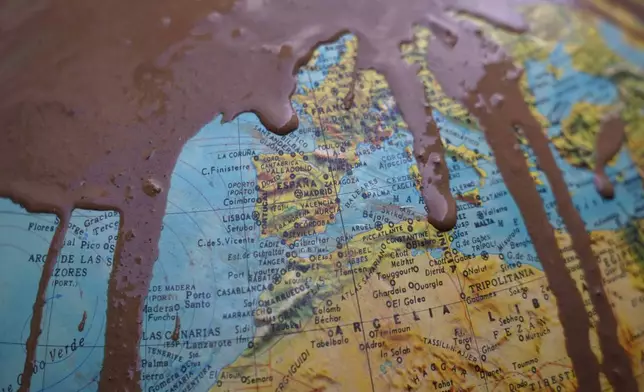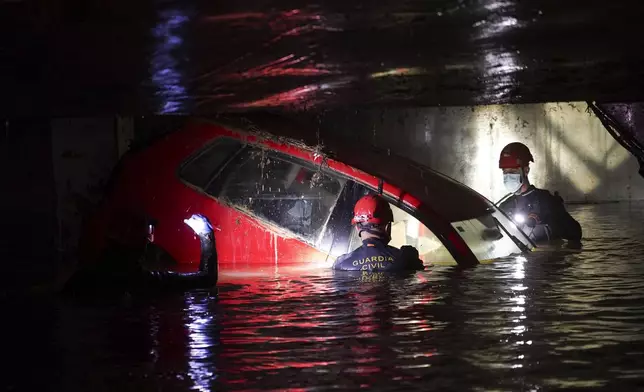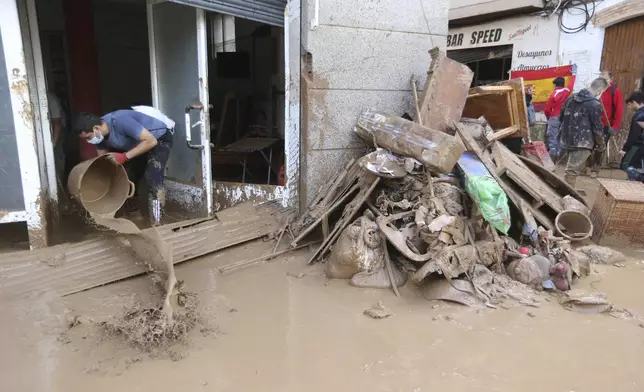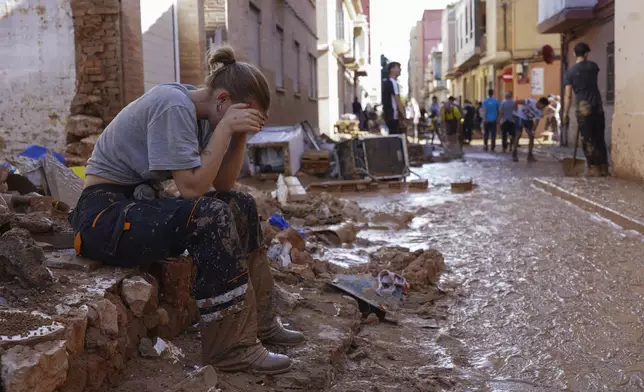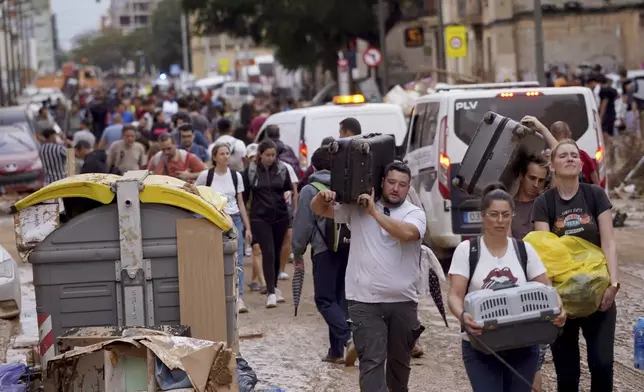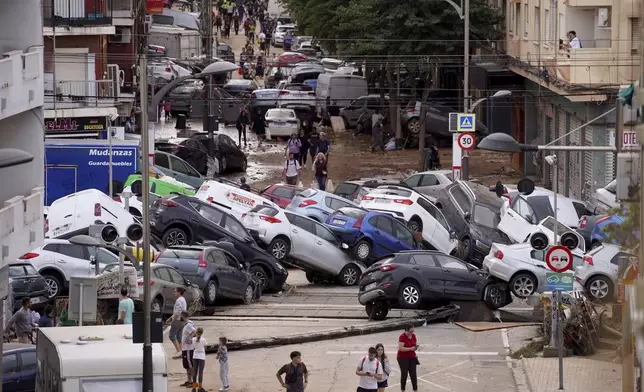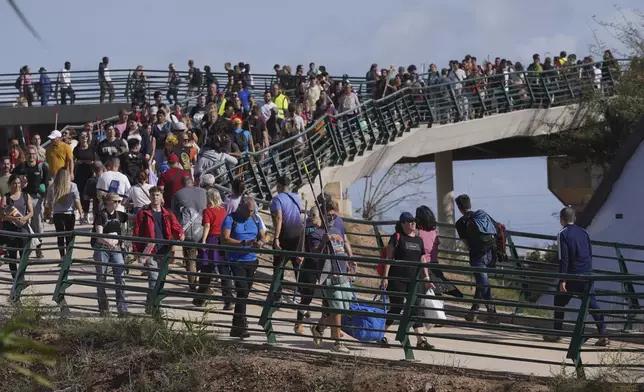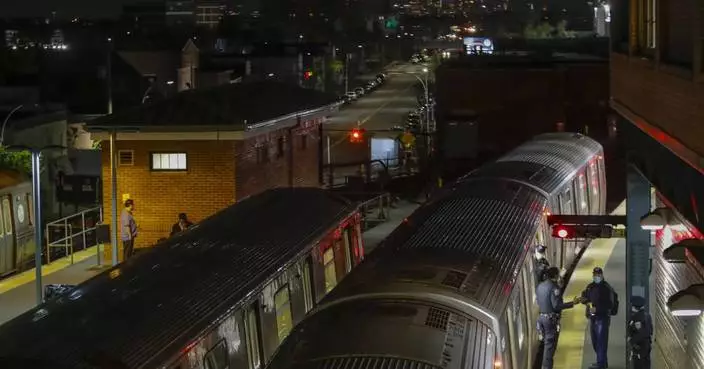BARCELONA, Spain (AP) — In a matter of minutes, flash floods caused by heavy downpours in eastern Spain swept away almost everything in their path. With no time to react, people were trapped in vehicles, homes and businesses. Many died and thousands of livelihoods were shattered.
A week later, authorities have recovered 219 bodies — 211 of them in the eastern region of Valencia — and are searching for at least 93 people who are unaccounted for. Police, firefighters and soldiers continued to search Tuesday for an unknown number of missing people.
In many of the over 70 impacted localities, mostly located in the southern outskirts of the city of Valencia, people still face shortages of basic goods. Water is back to running through pipes but authorities say it is only for cleaning and not fit for drinking. Lines form at impromptu emergency kitchens and food relief stands in streets still covered with mud and debris.
Spain’s Consortium for Insurance, a public-private entity that pays insurance claims for extreme risks like floods, said Tuesday that it had received 21,000 claims of home insurance, 12,000 for business properties, and 44,000 for motor vehicles for flood damage. Those numbers are expected to grow.
“We can estimate that we are facing the biggest payout for a weather-related event that Spain has ever suffered,” said Mirenchu del Valle Schaan, president of Spain’s Association of Insurance Companies.
Thousands of volunteers are helping soldiers and police reinforcements with the gargantuan task of cleaning up the mire and the countless wrecked cars.
The ground floors of thousands of homes have been ruined. Inside some of the vehicles that the water washed away or trapped in underground garages, there were still bodies waiting to be identified.
The frustration over the crisis management boiled over on Sunday when a crowd in hard-hit Paiporta hurled mud and other objects at Spain’s royals, Prime Minister Pedro Sánchez and regional officials when they made their first visit to the epicenter of the flood damage.
Another seven people died in Castilla La Mancha and one in Andalusia.
Here are a few things to know about Spain’s deadliest natural disaster of the century:
The storms concentrated over the Magro and Turia river basins and, in the Poyo canal, produced walls of water that overflowed riverbanks, catching people unaware as they went on with their daily lives on Tuesday evening and early Wednesday.
In the blink of an eye, the muddy water covered roads and railways, and entered houses and businesses in towns and villages on the southern outskirts of Valencia. Drivers had to take shelter on car roofs, while residents took refuge on higher ground.
Spain’s national weather service said that in the hard-hit locality of Chiva, it rained more in eight hours than it had in the preceding 20 months, calling the deluge “extraordinary.” Other areas on the southern outskirts of Valencia city didn't get rain before they were wiped out by the wall of water that overflowed the drainage canals.
When authorities sent alerts to mobile phones warning of the seriousness of the flooding and asking people to stay at home, many were already on the road, working or covered in water in low-lying areas or underground garages, which became death traps.
Scientists trying to explain what happened see two likely connections to human-caused climate change. One is that warmer air holds and then dumps more rain. The other is possible changes in the jet stream — the river of air above land that moves weather systems across the globe — that spawn extreme weather.
Climate scientists and meteorologists said the immediate cause of the flooding is called a cut-off lower-pressure storm system that migrated from an unusually wavy and stalled jet stream. That system simply parked over the region and poured rain. This happens often enough that in Spain they call them DANAs, the Spanish acronym for the system, meteorologists said.
And then there is the unusually high temperature of the Mediterranean Sea. It had its warmest surface temperature on record in mid-August, at 28.47 degrees Celsius (83.25 degrees Fahrenheit), said Carola Koenig of the Centre for Flood Risk and Resilience at Brunel University of London.
The extreme weather event came after Spain battled with prolonged droughts in 2022 and 2023. Experts say that drought and flood cycles are increasing with climate change.
"Climate change kills, and now, unfortunately, we are seeing it firsthand,” Sánchez said Tuesday after announcing a 10.6-billion-euro relief package for 78 municipalities where at least one person had died.
Spain’s Mediterranean coast is used to autumn storms that can cause flooding, but this episode was the most powerful flash flood in the region in recent memory.
Older people in Paiporta, at the epicenter of the tragedy, say the floods were three times as bad as those in 1957, which caused at least 81 deaths. That episode led to the diversion of the Turia watercourse, which meant that a large part of the town was spared of these floods.
Valencia suffered two other major DANAs in the 1980s, one in 1982 with around 30 deaths, and another one five years later that broke rainfall records.
Management of the crisis is in the hands of the regional Valencian authorities, who asked the central government for help in mobilizing resources.
Some 15,000 soldiers, National Police officers, and Civil Guard gendarmeries have deployed to the area in the largest peacetime mobilization of military and security forces inside Spain. Military trucks, heavy road equipment, Chinook helicopters, and a navy transport vessel are aiding with the distribution of relief aid, the cleaning, and the search for bodies. Two thousand firefighters and 500 local police are also involved.
The national government said that as of Tuesday authorities had rescued over 36,000 people, restored electricity to 147,000 homes and distributed some 130,000 bottles of water and 21,000 food rations.
When many of those affected said they felt abandoned by the authorities, a wave of volunteers arrived to help. Carrying brooms, shovels, water and basic foods, hundreds of people walked several kilometers to deliver supplies and help clean up the worst-affected areas.
The Valencian regional government has been heavily criticized for not sending out flood warnings to cellphones until 8 p.m. on Tuesday, when the flooding had already started in some places and well after the national weather agency issued a red alert indicating heavy rains.
Medrano reported from Madrid.
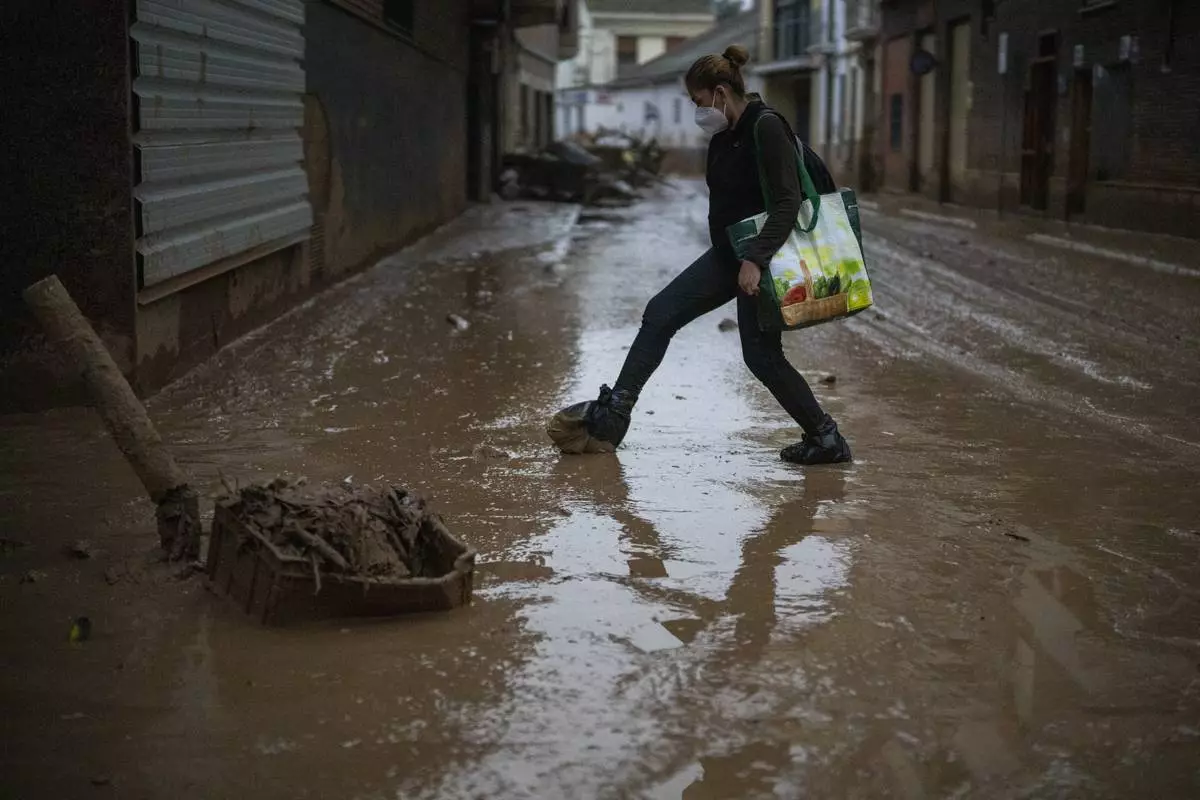
A woman walks on a mud-covered street in Masanasa, Valencia, Spain, Wednesday, Nov. 6, 2024. (AP Photo/Emilio Morenatti)
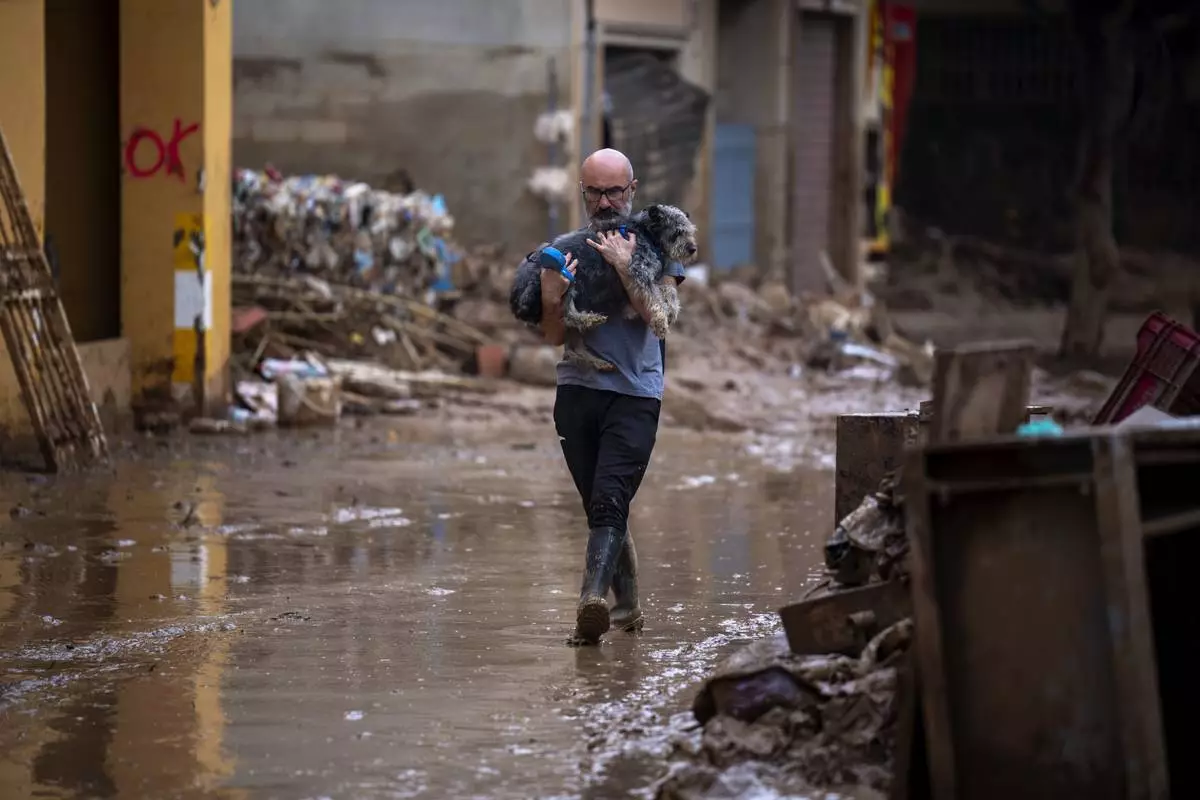
Chimo carries his dog Lou as he walks through the muddy streets after the floods in in Masanasa, Valencia, Spain, Wednesday, Nov. 6, 2024. (AP Photo/Emilio Morenatti)
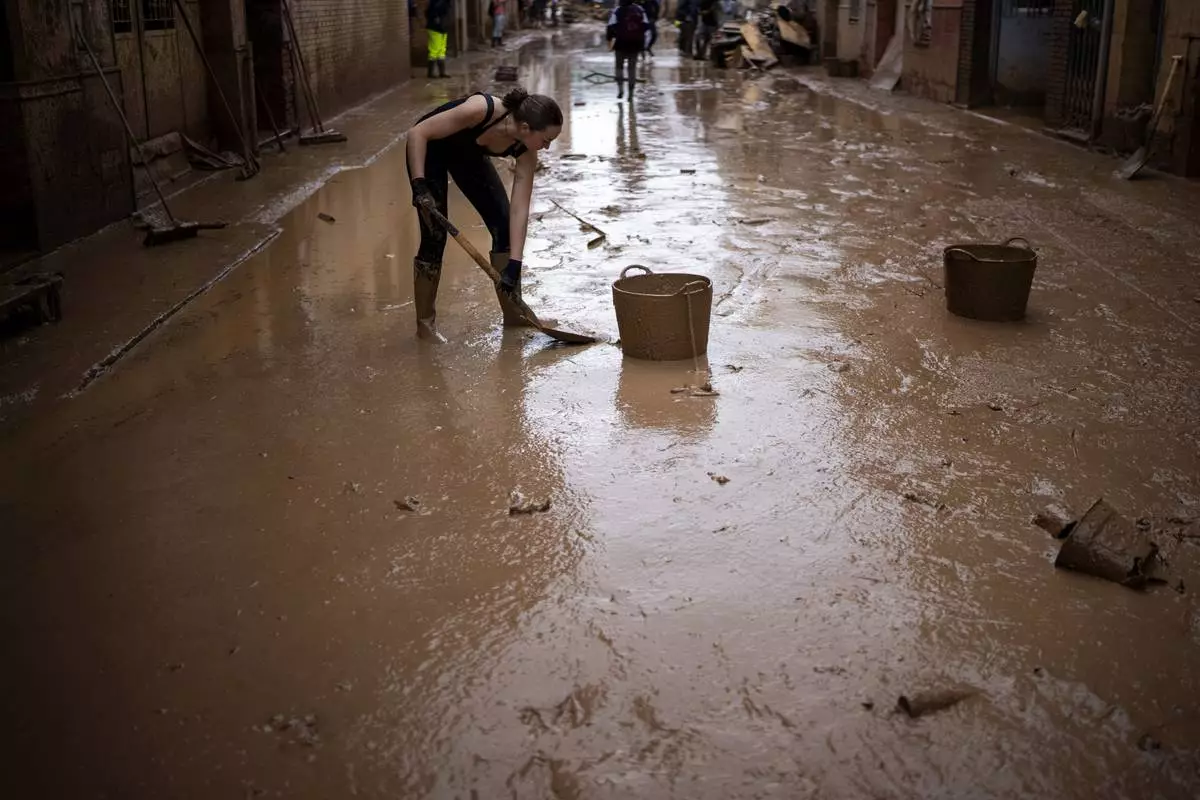
Anna Romeu, 24, removes mud from the street next to her flood-affected home in Masanasa, Valencia, Spain, Wednesday, Nov. 6, 2024. (AP Photo/Emilio Morenatti)
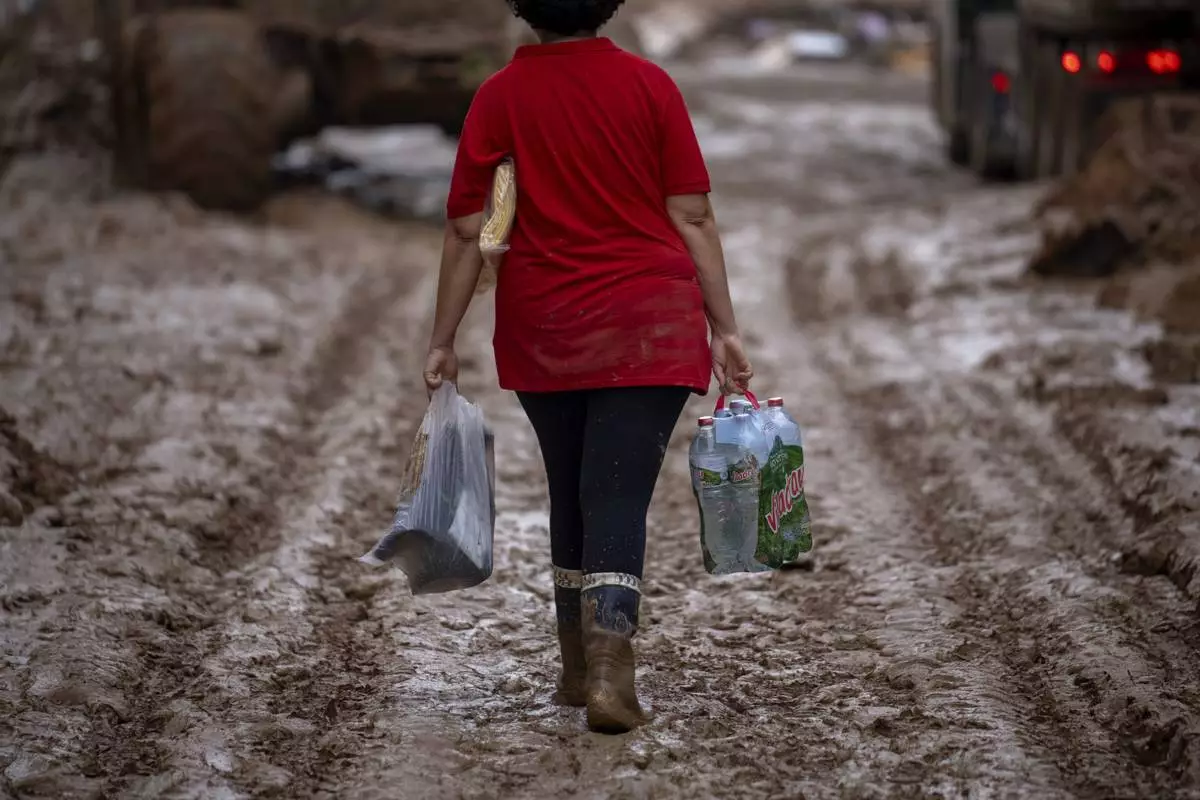
A woman carrying water and boots walks through the muddy streets after the floods in in Masanasa, Valencia, Spain, Wednesday, Nov. 6, 2024. (AP Photo/Emilio Morenatti)
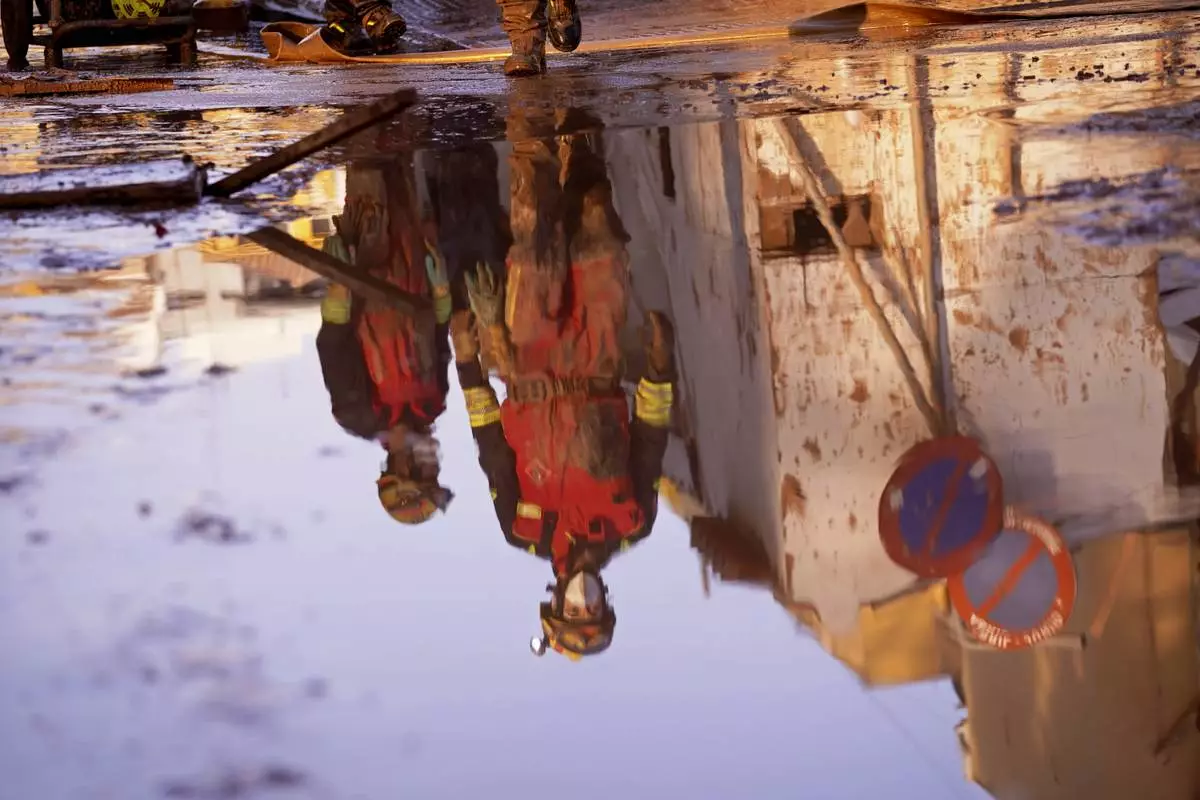
Firefighters walk during the clean up operation after flooding in Massanassa on the outskirts of Valencia, Spain, Wednesday, Nov. 6, 2024. (AP Photo/Alberto Saiz)

Two women walk in the mud after floods in Catarroja on the outskirts of Valencia, Spain, Tuesday, Nov. 5, 2024. (AP Photo/Alberto Saiz)

People collect some clothes outside a charity distribution point after floods in Catarroja on the outskirts of Valencia, Spain, Tuesday, Nov. 5, 2024. (AP Photo/Alberto Saiz)

People walk through a street with piled furniture and rubbish on the sides in an area, affected by floods, in Paiporta, Valencia, Spain, Tuesday, Nov. 5, 2024. (AP Photo/Emilio Morenatti)
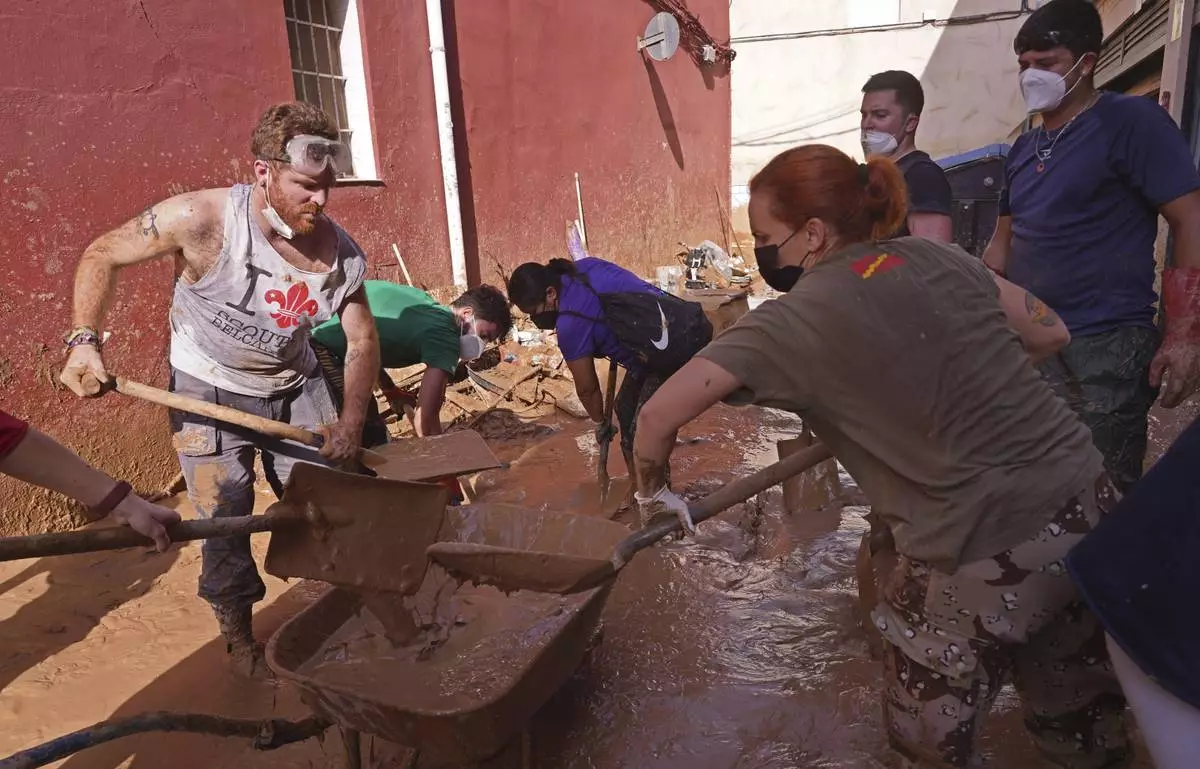
People shovel up mud after floods in Catarroja on the outskirts of Valencia, Spain, Tuesday, Nov. 5, 2024. (AP Photo/Alberto Saiz)

Part of a rotating World Globe Map showing Spain is covered in mud after floods in Paiporta, near Valencia, Spain, Monday, Nov. 4, 2024. (AP Photo/Alberto Saiz)
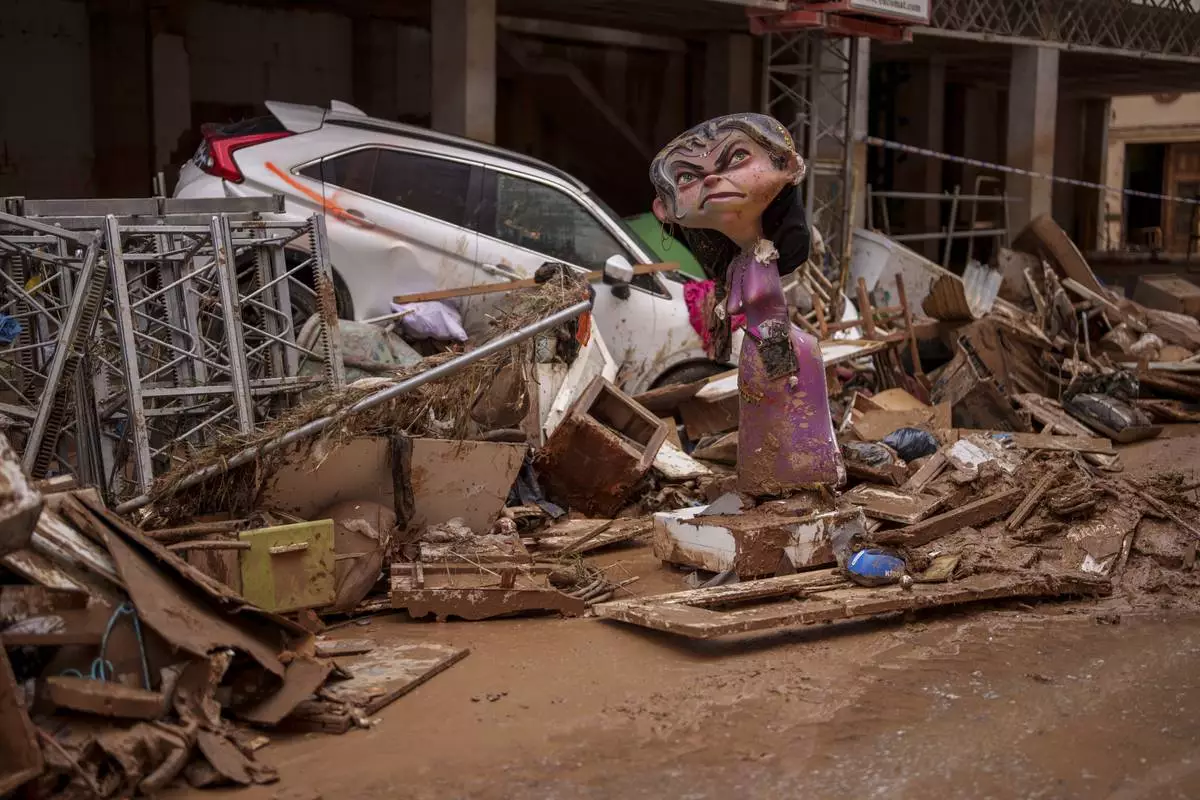
A "Falla" figure structure made of cardboard and other materials is damaged in an area affected by floods in Catarroja, Spain, on Monday, Nov. 4, 2024. (AP Photo/Manu Fernandez)
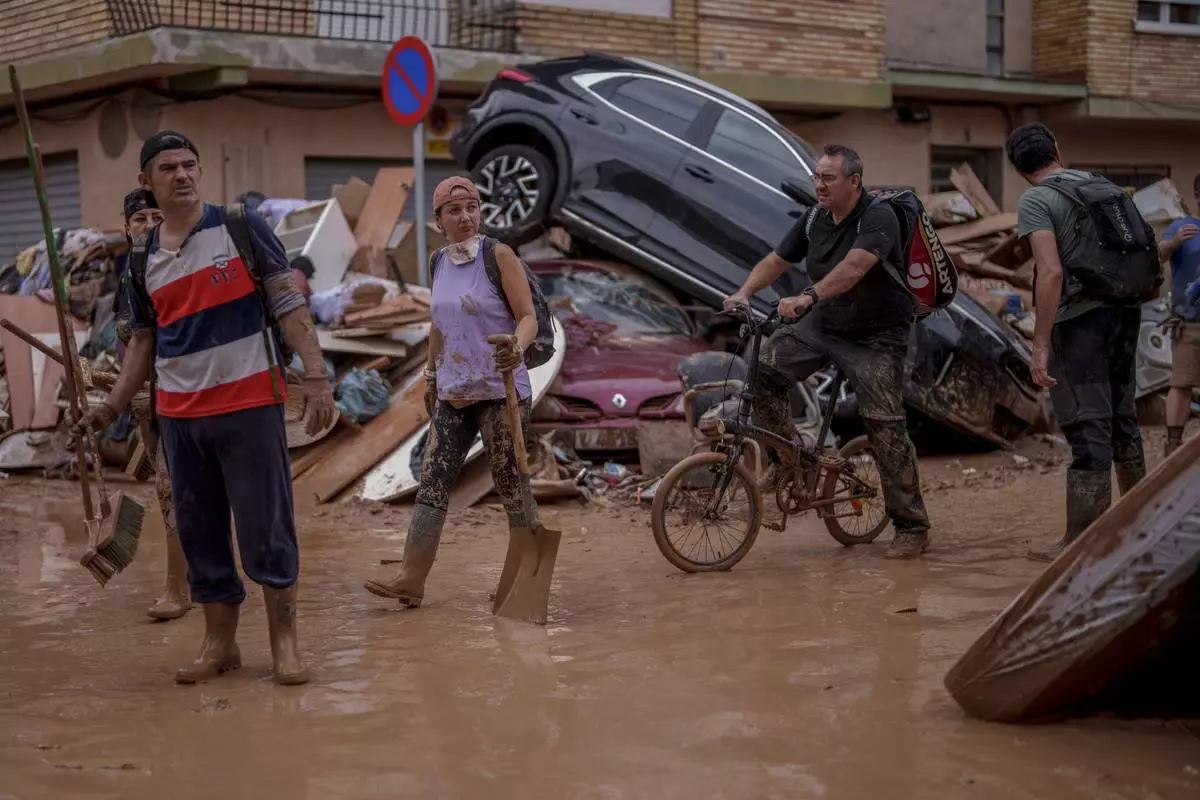
People walk through an area affected by floods in Catarroja, Spain, on Monday, Nov. 4, 2024. (AP Photo/Manu Fernandez)
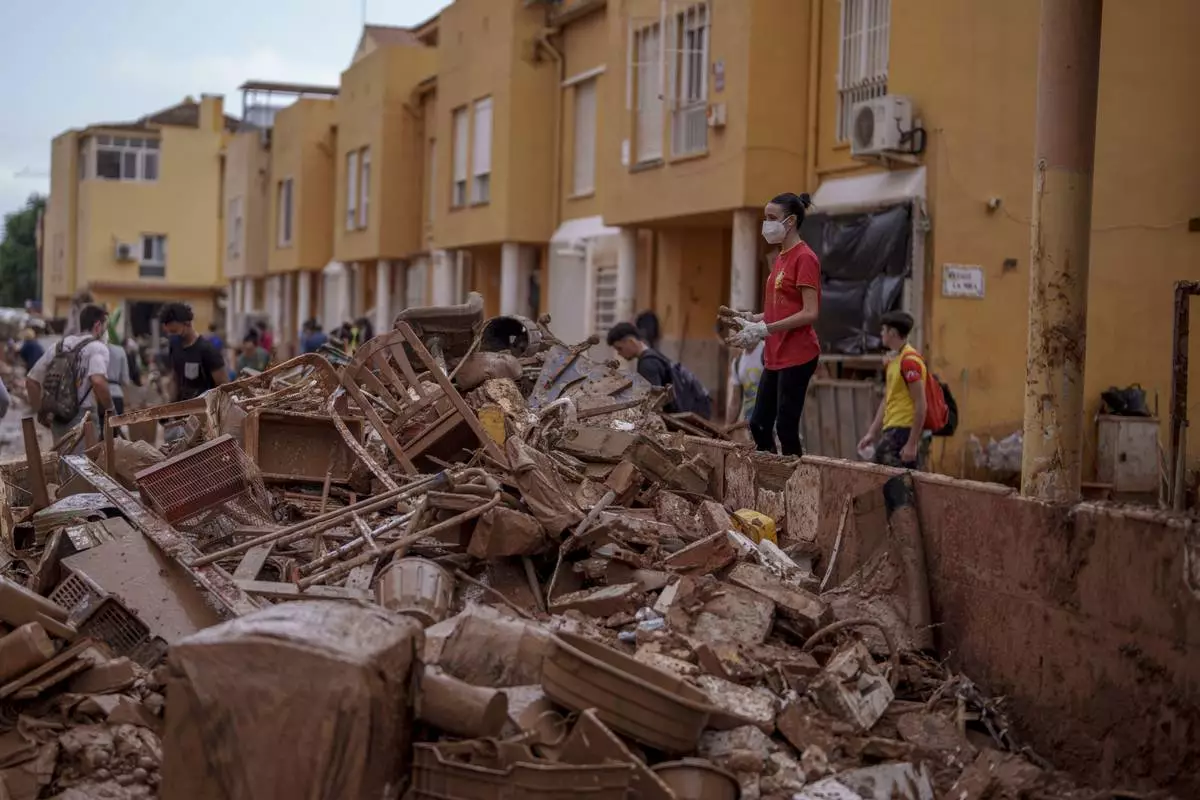
A woman stacks belongings covered in mud from a house in Catarroja, Spain, on Monday, Nov. 4, 2024. (AP Photo/Manu Fernandez)
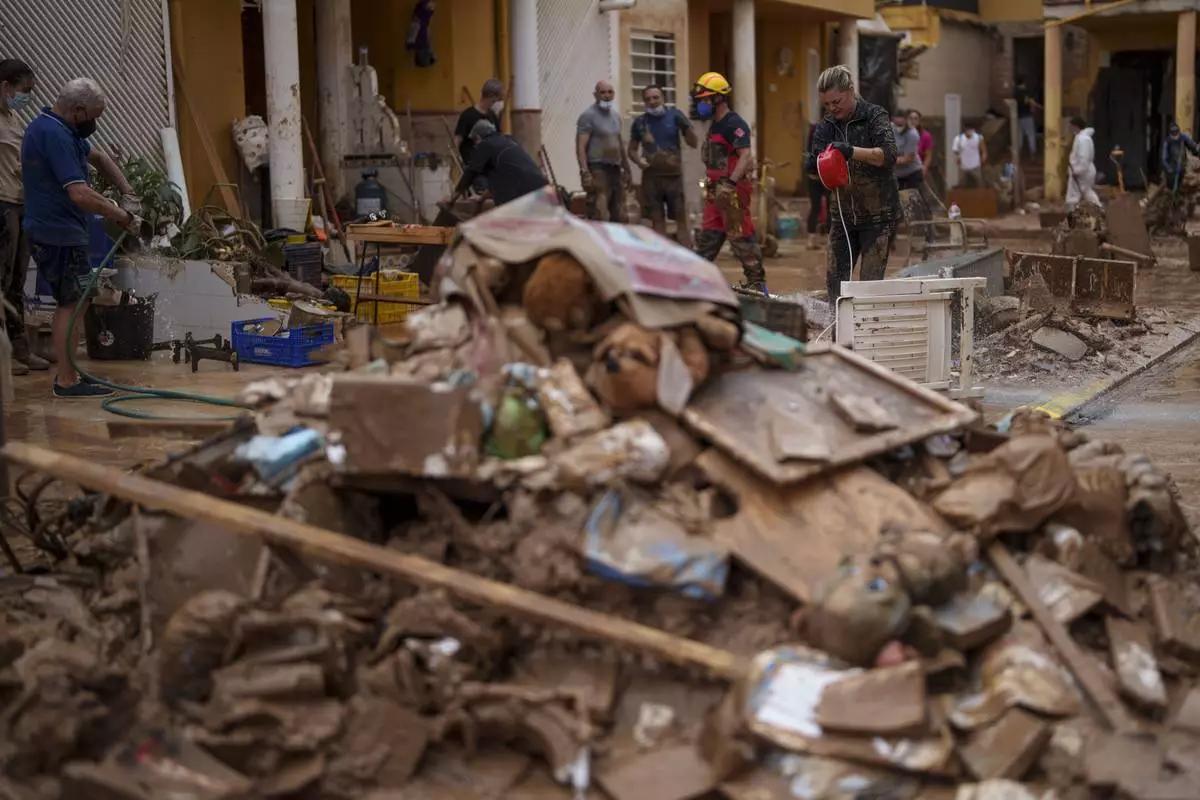
People clean items covered in mud in an area affected by floods in Catarroja, Spain, on Monday, Nov. 4, 2024. (AP Photo/Manu Fernandez)
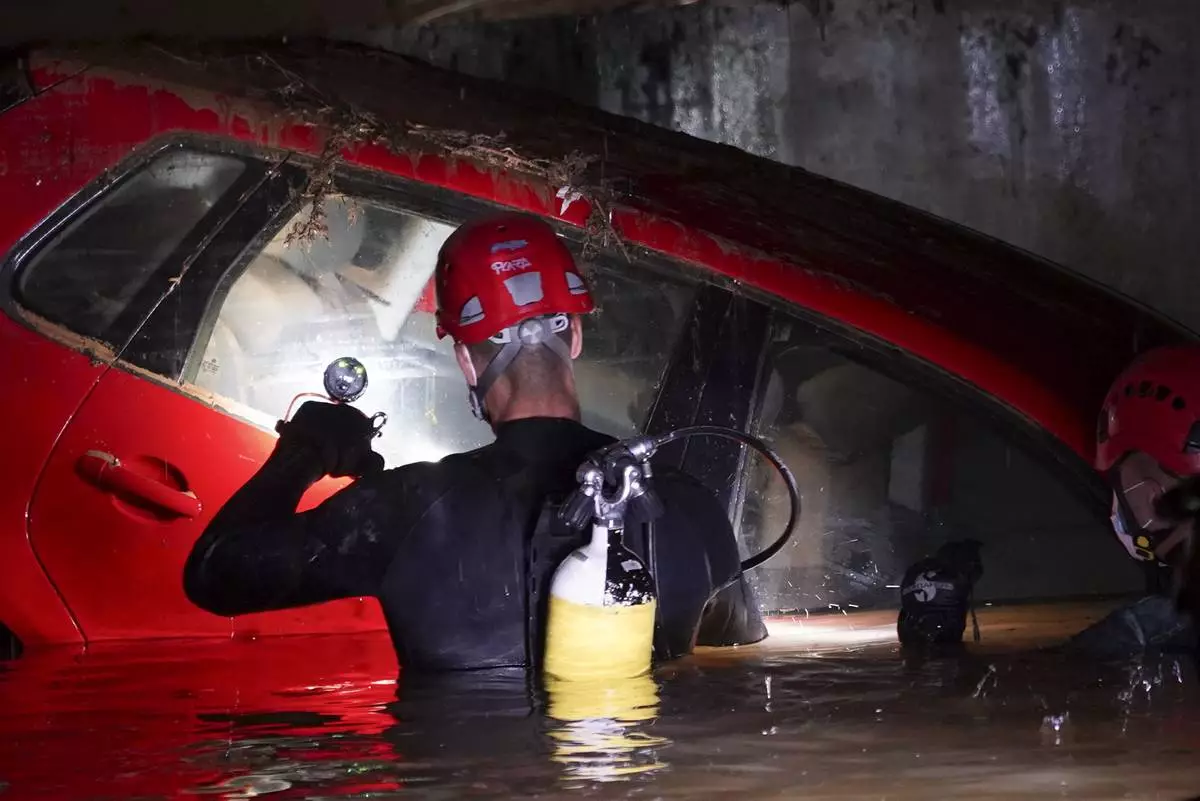
Civil Guards walk in a flooded indoor car park to check cars for bodies after floods in Paiporta, near Valencia, Spain, Monday, Nov. 4, 2024. (AP Photo/Alberto Saiz)

Civil Guards walk in a flooded indoor car park to check cars for bodies after floods in Paiporta, near Valencia, Spain, Monday, Nov. 4, 2024. (AP Photo/Alberto Saiz)
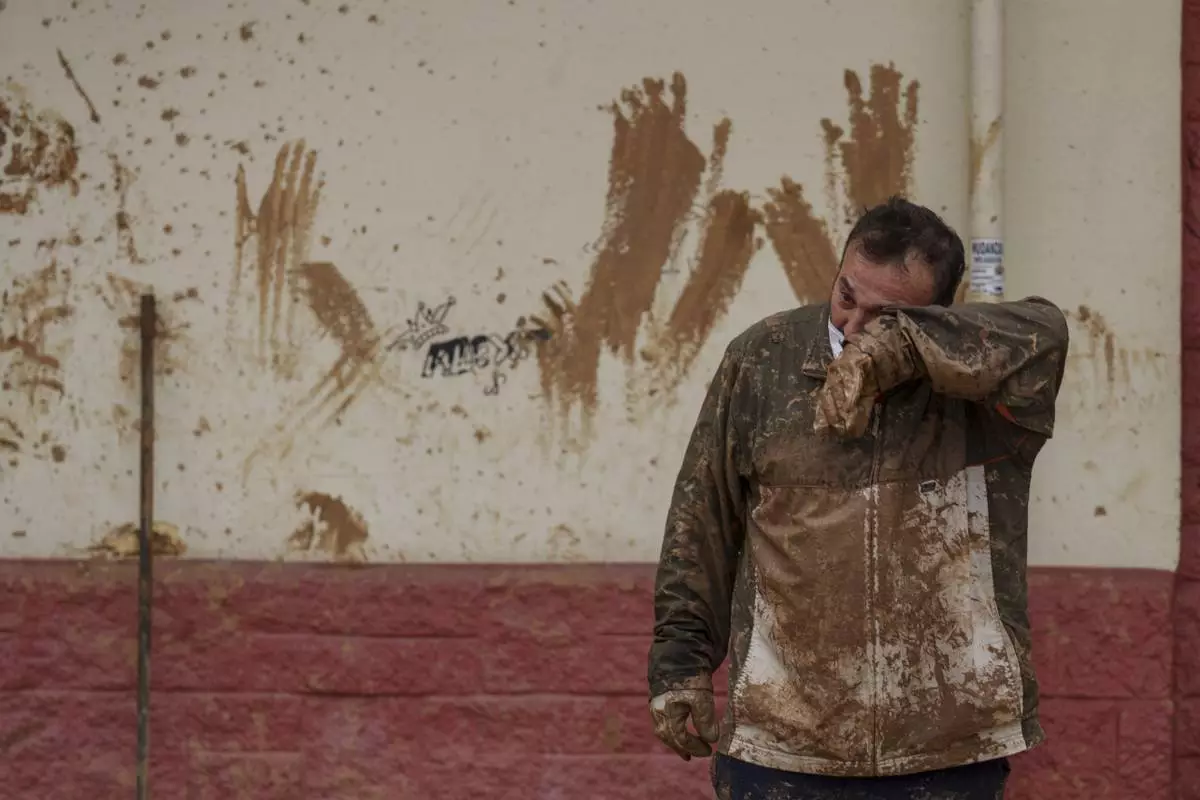
A man wipes mud off his face in an area affected by floods in Catarroja, Spain, on Monday, Nov. 4, 2024. (AP Photo/Manu Fernandez)
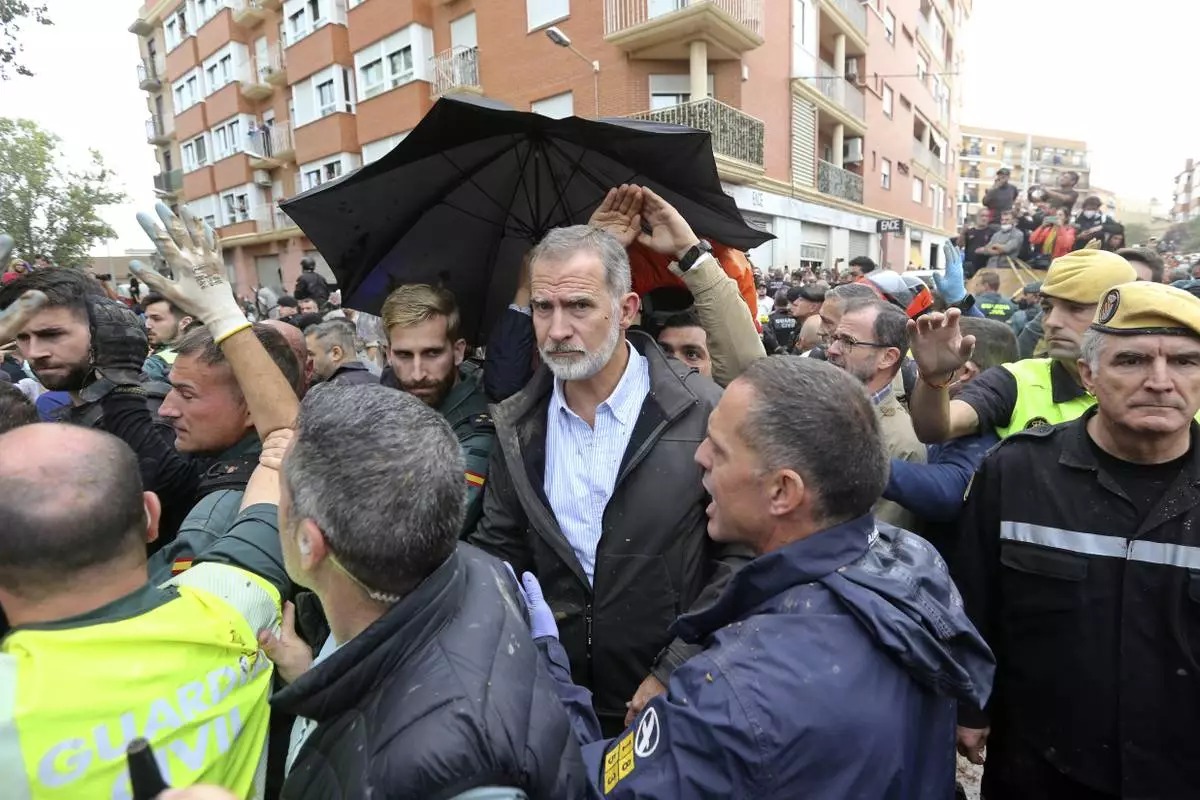
Spain's King Felipe VI is protected after a crowd of angry survivors of Spain's floods have tossed mud and shouted insults at the King and government officials when they made their first visit to one of the hardest hit towns after floods in Paiporta near Valencia, Spain, Sunday, Nov. 3, 2024. (AP Photo/Hugo Torres)
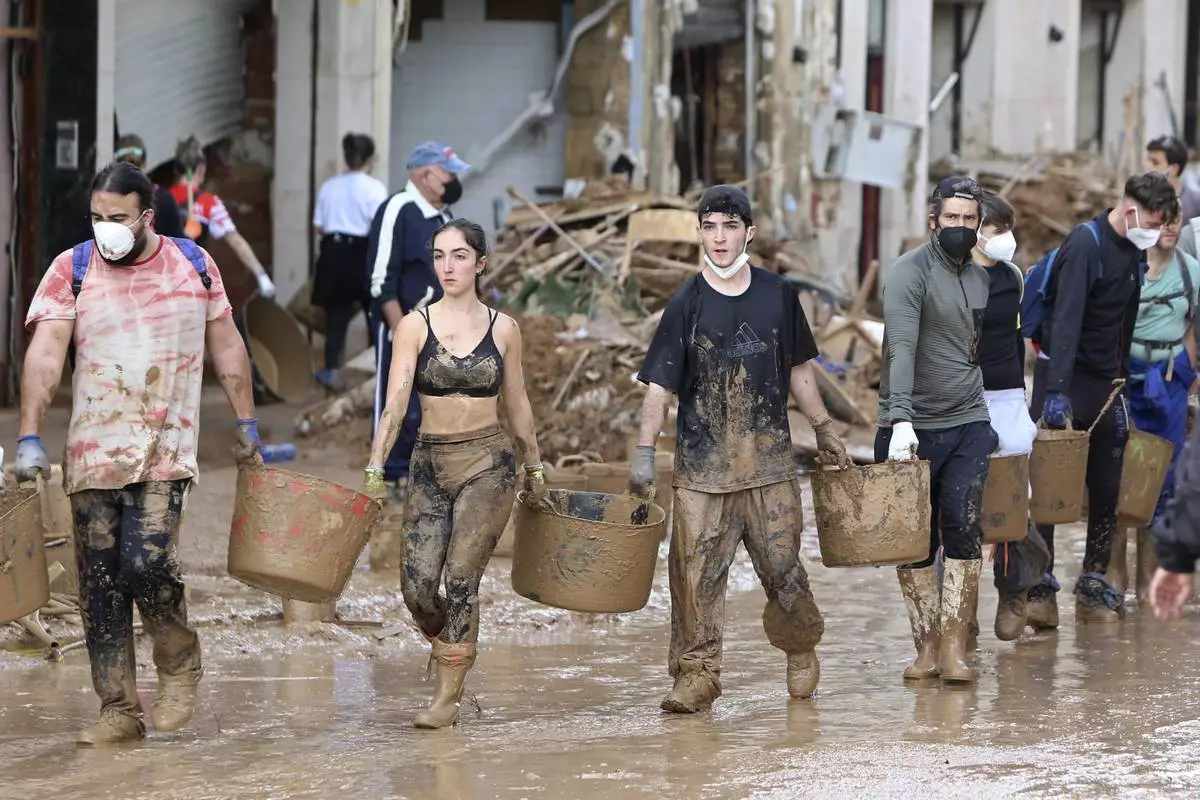
Volunteers carry buckets of mud after floods in Paiporta, Spain, Sunday, Nov. 3, 2024. (AP Photo/Hugo Torres)
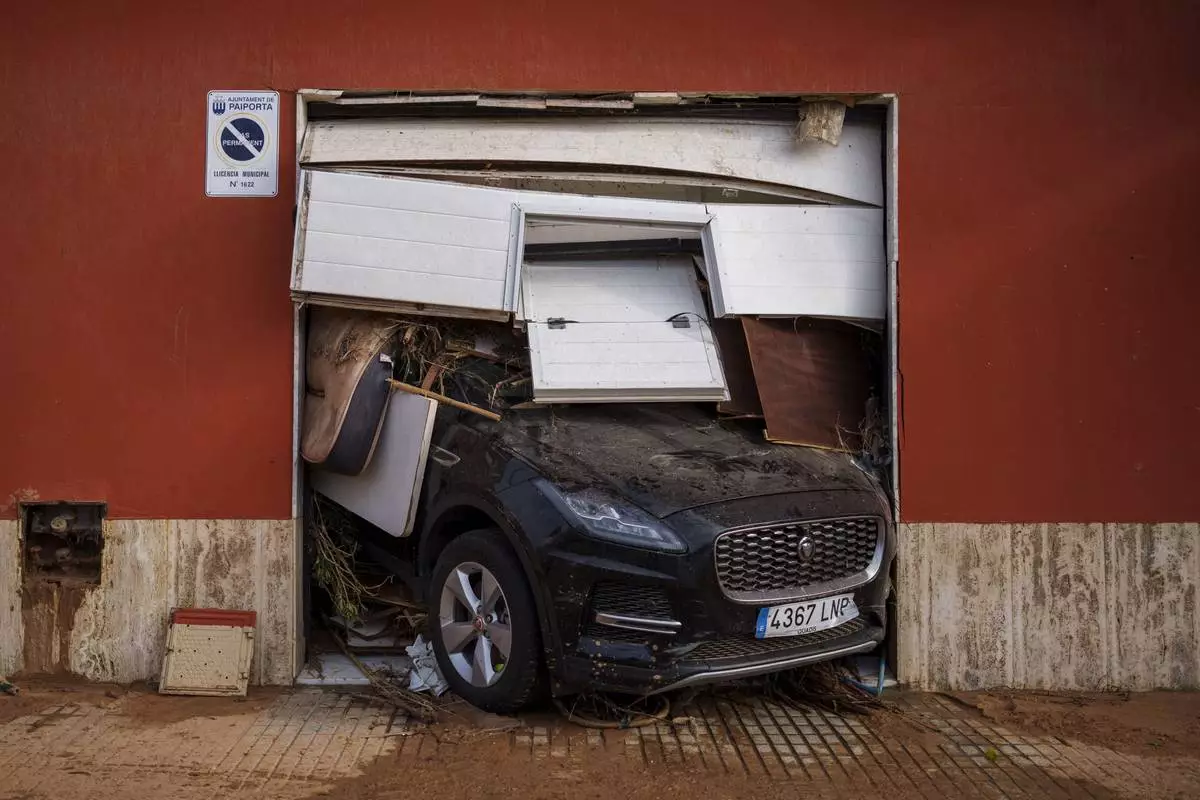
A car sticks out of a garage with debris after flooding in Valencia, Spain, Saturday, Nov. 2, 2024. (AP Photo/Manu Fernandez)
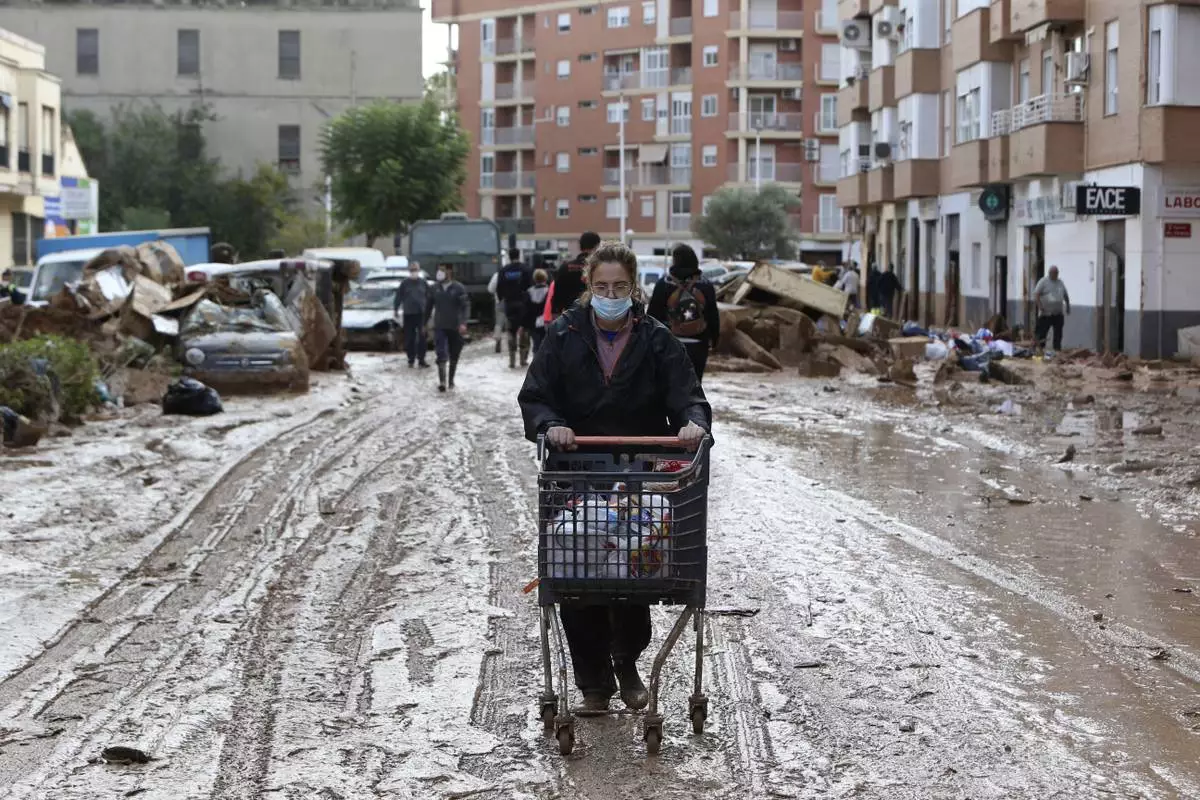
A woman pushes a supermarket trolley with food in a muddy street after floods in Paiporta, near Valencia, Spain, Sunday, Nov. 3, 2024. (AP Photo/Hugo Torres)
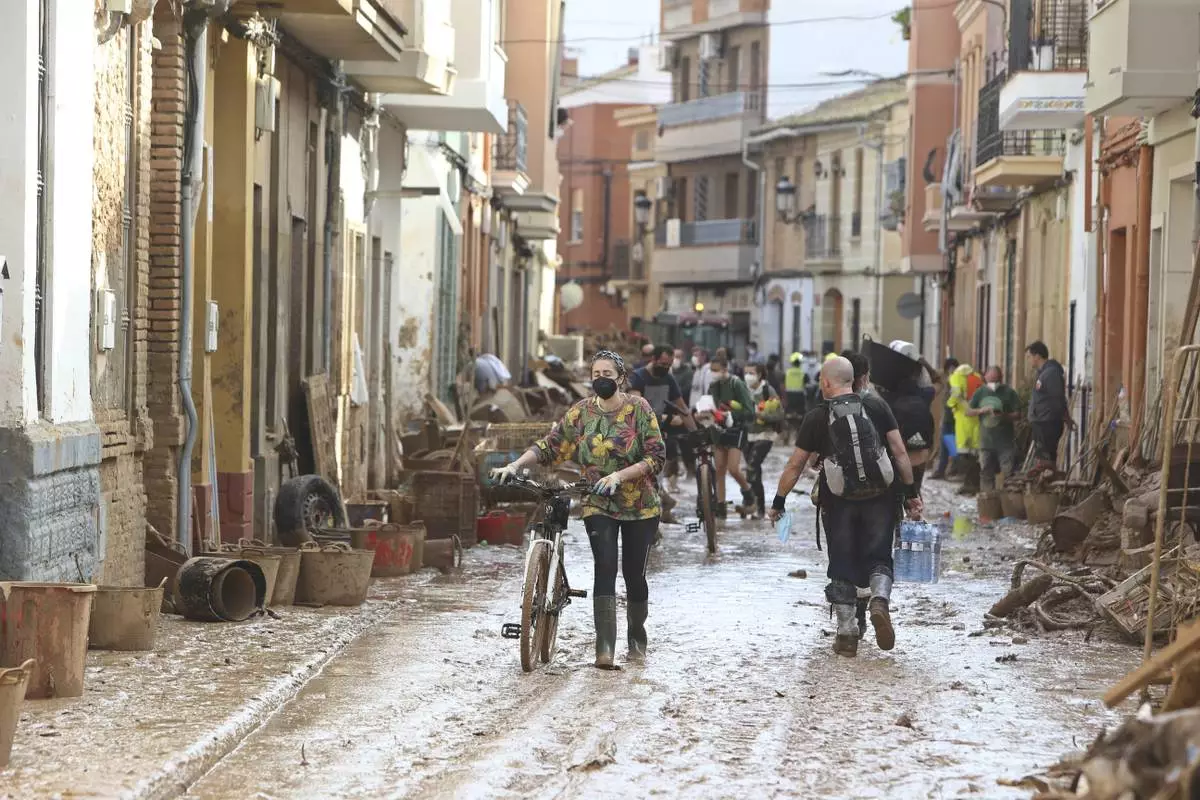
A woman pushes a bicycle along a muddy street after floods in Paiporta, near Valencia, Spain, Sunday, Nov. 3, 2024. (AP Photo/Hugo Torres)

A man pours muddy water out of the entrance of a building after floods in Paiporta, near Valencia, Spain, Sunday, Nov. 3, 2024. (AP Photo/Hugo Torres)
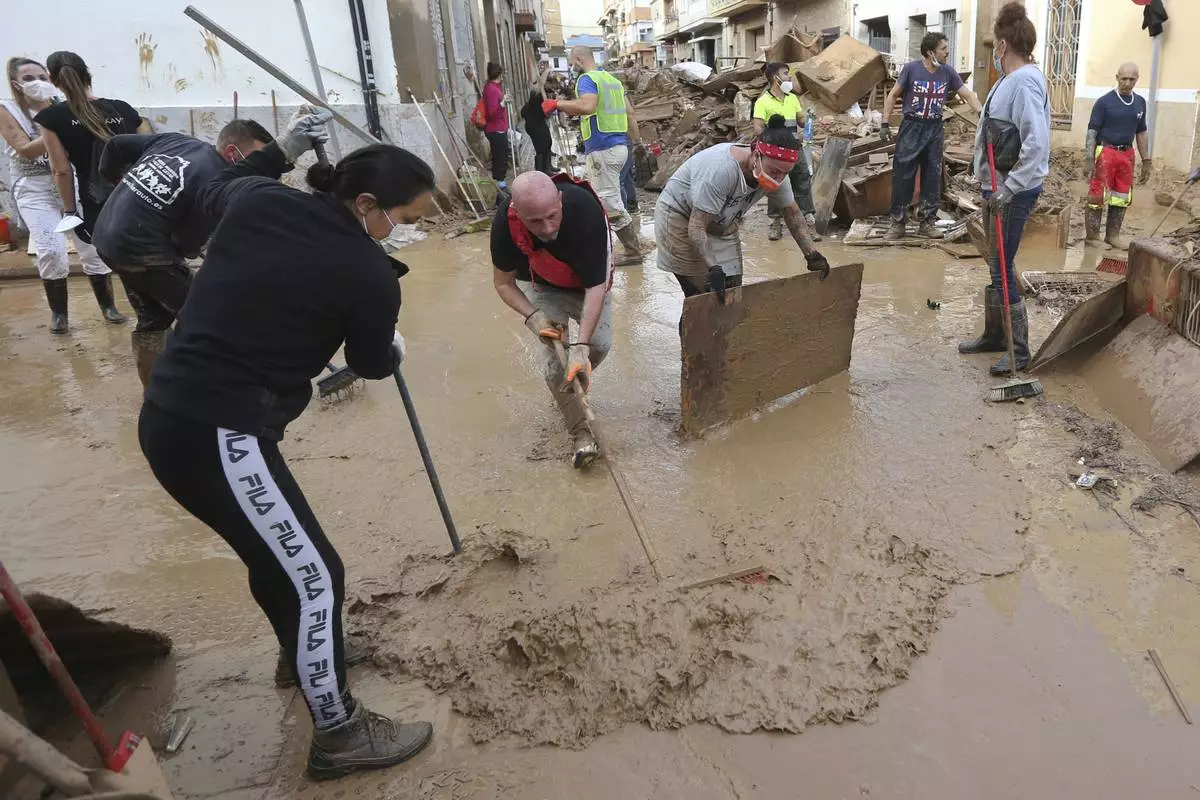
Residents and volunteers sweep away mud after floods in Paiporta, near Valencia, Spain, Sunday, Nov. 3, 2024. (AP Photo/Hugo Torres)
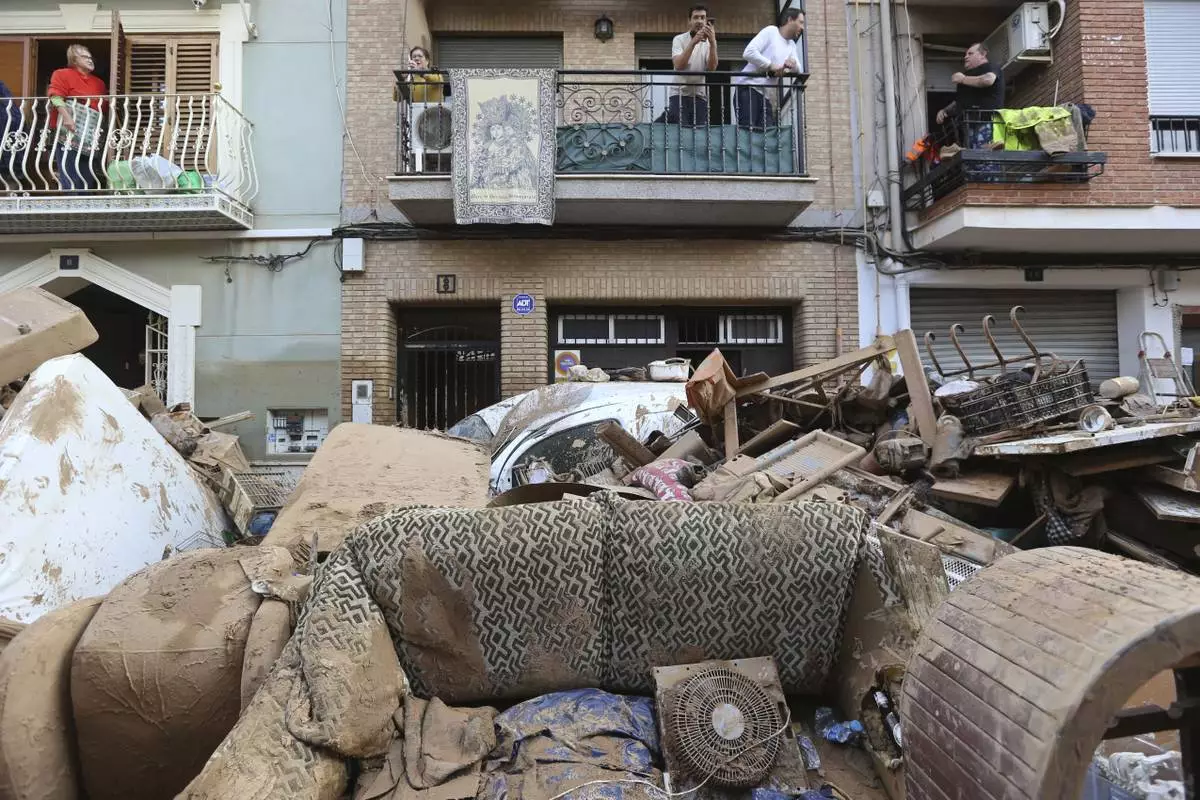
Residents stand on their balconies above destroyed furniture below after floods in Paiporta, near Valencia, Spain, Sunday, Nov. 3, 2024. (AP Photo/Hugo Torres)
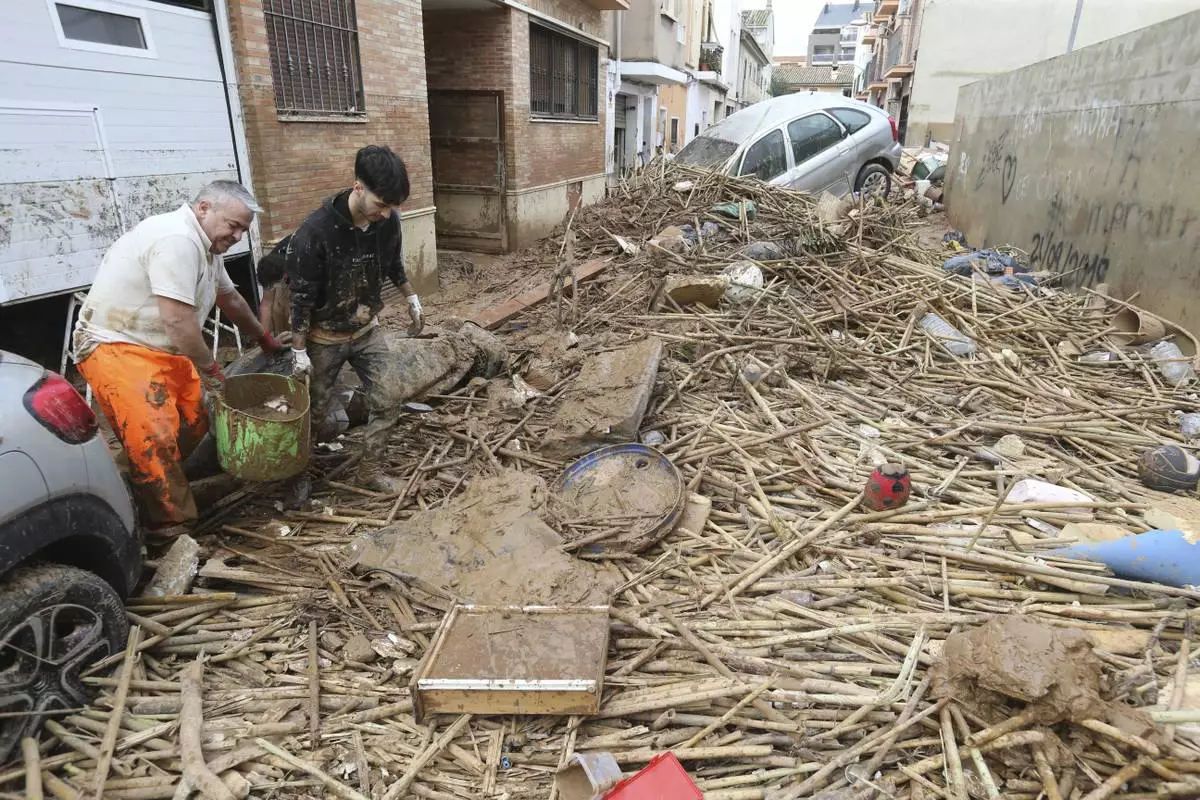
Two men carry a bucket of mud after floods in Paiporta, near Valencia, Spain, Sunday, Nov. 3, 2024. (AP Photo/Hugo Torres)

A woman rests as residents and volunteers clean up an area affected by floods in Paiporta, near Valencia, Spain, Friday, Nov. 1, 2024. (AP Photo/Alberto Saiz)

Firefighters walk as people try to clear up the damage after floods in Massanassa, just outside of Valencia, Spain, Friday, Nov. 1, 2024. (AP Photo/Alberto Saiz)

Residents carry their belongings as they leave their houses affected by floods in Valencia, Spain, Thursday, Oct. 31, 2024. (AP Photo/Alberto Saiz)
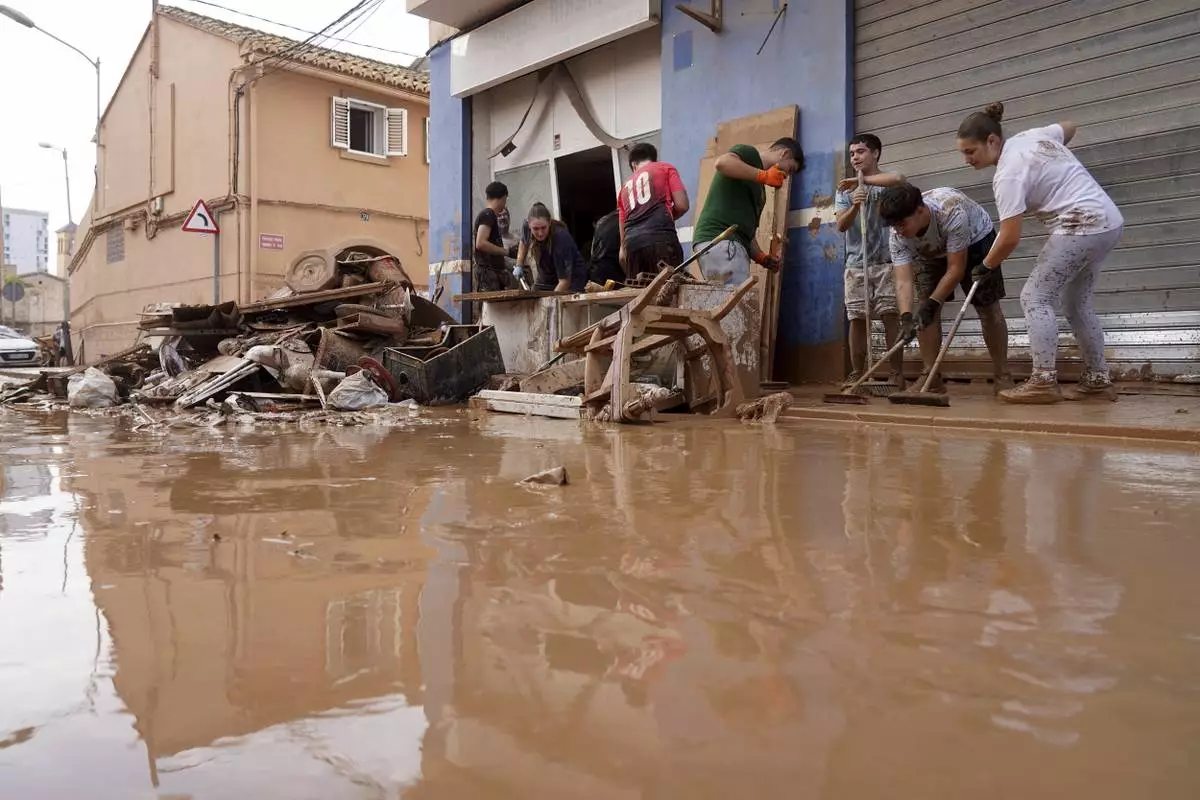
Residents clean their house affected by floods in Valencia, Spain, Thursday, Oct. 31, 2024. (AP Photo/Alberto Saiz)

Vehicles are seen piled up after being swept away by floods in Valencia, Spain, Thursday, Oct. 31, 2024. (AP Photo/Alberto Saiz)
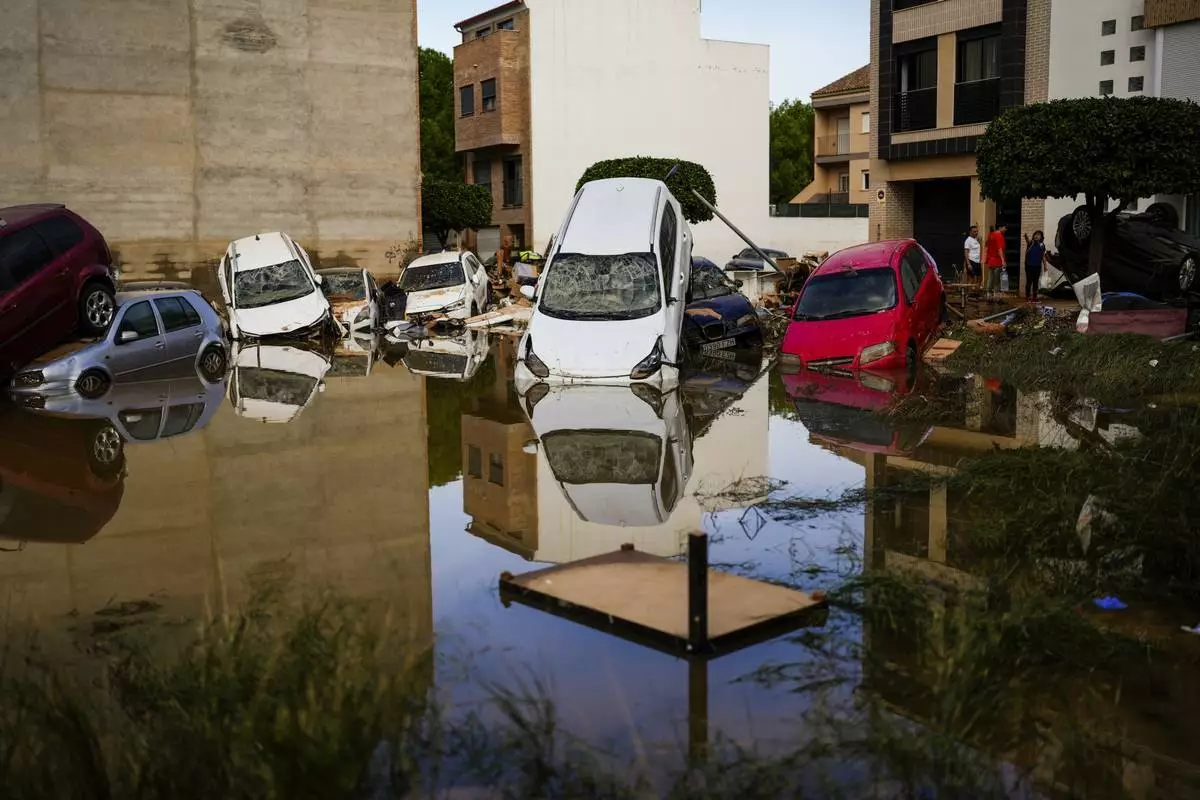
Flooded cars piled up are pictured in Valencia, Spain, Thursday, Oct. 31, 2024. (AP Photo/Manu Fernandez)

Residents from the Valencia area walk carrying cleaning instruments to help in the flooded areas in the La Torre neighbourhood of Valencia, Spain, Friday, Nov. 1, 2024. (AP Photo/Alberto Saiz)
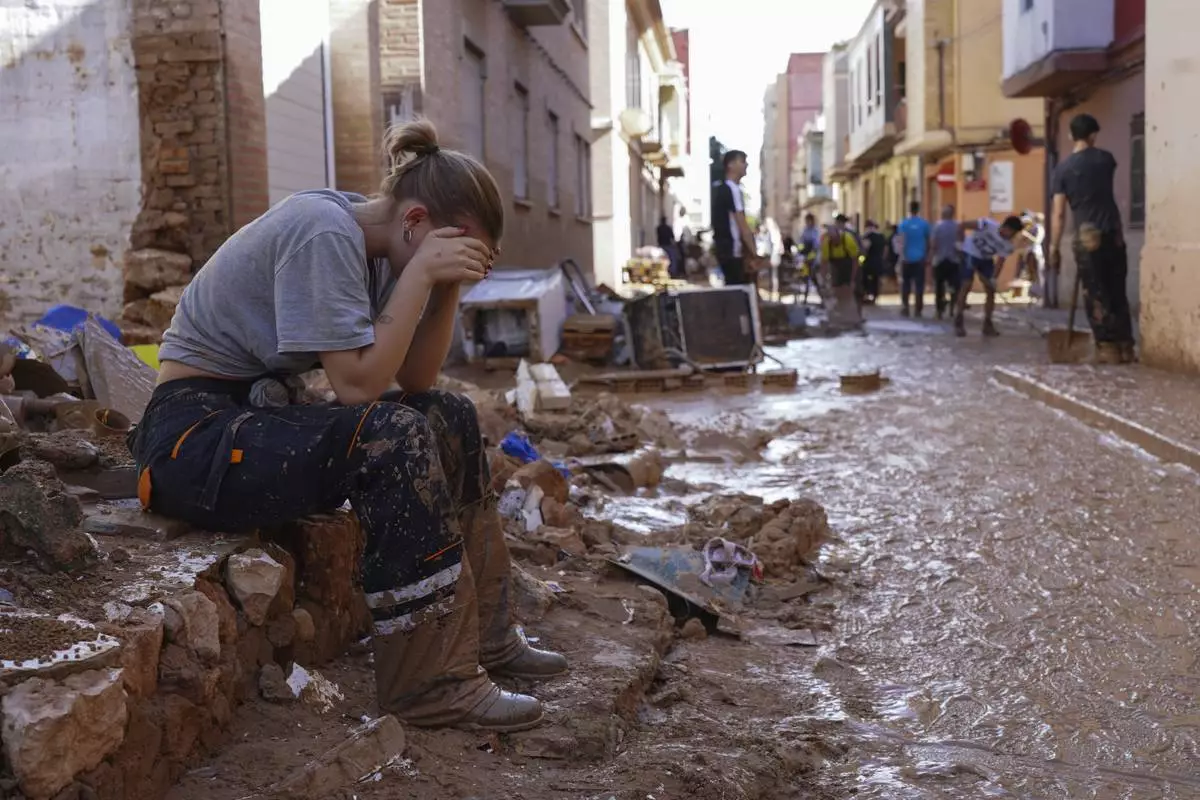
A woman rests as residents and volunteers clean up an area affected by floods in Paiporta, near Valencia, Spain, Friday, Nov. 1, 2024. (AP Photo/Alberto Saiz)
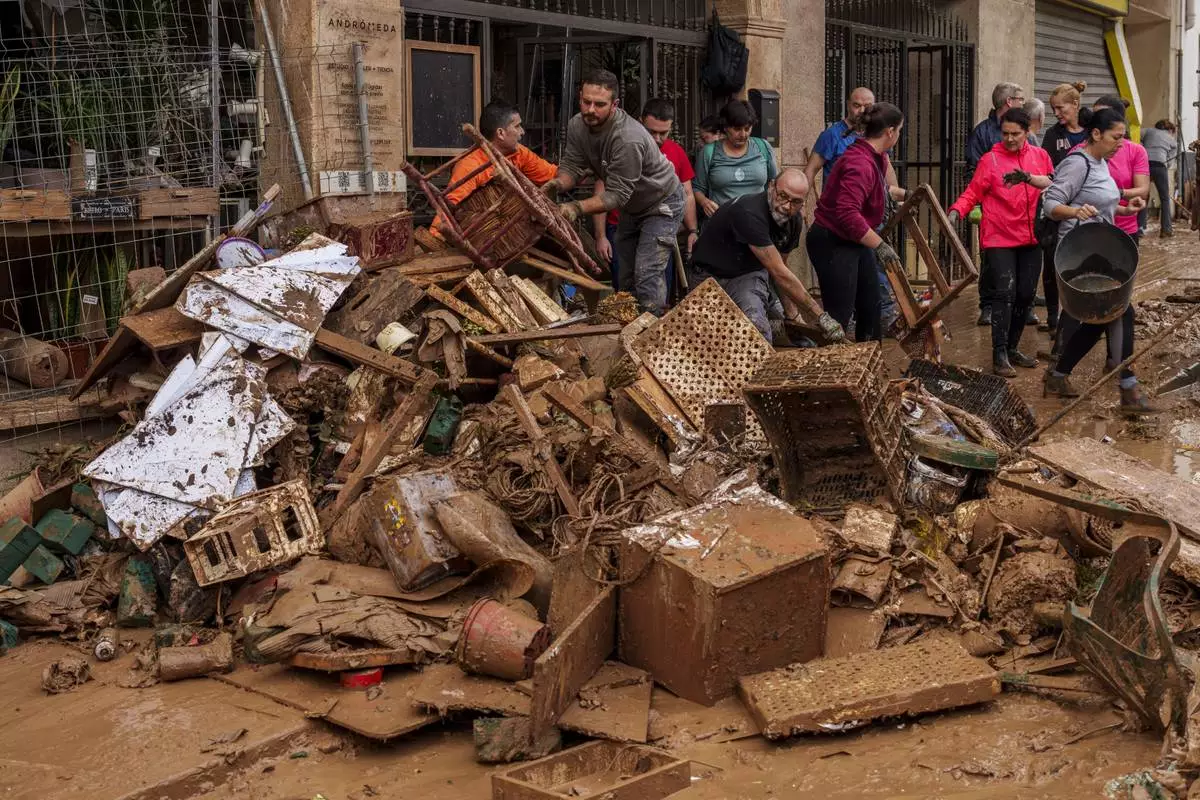
People clean mud from a shop affected by floods in Chiva, Spain, Friday, Nov. 1, 2024. (AP Photo/Manu Fernandez)


